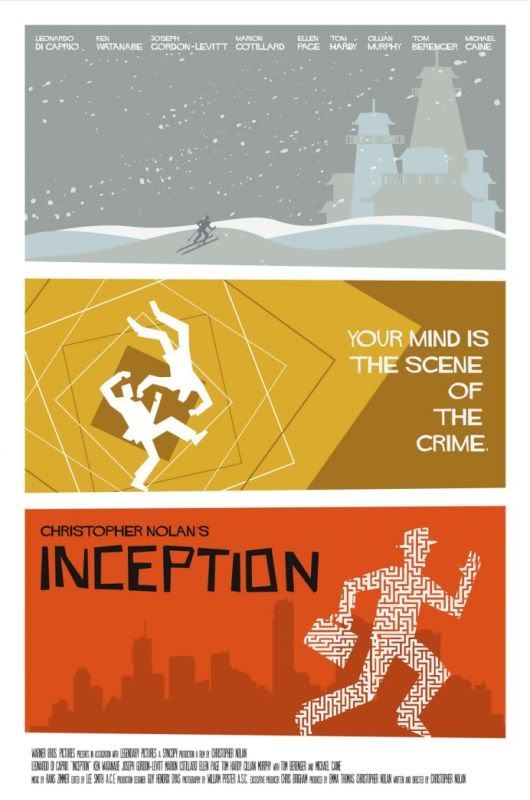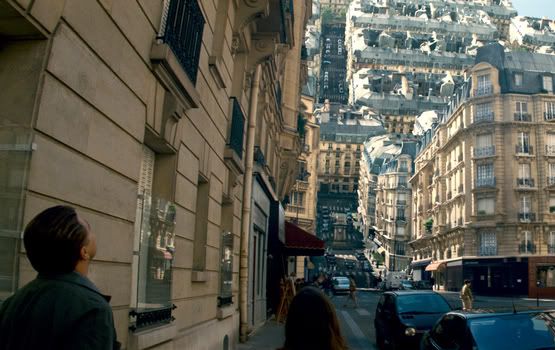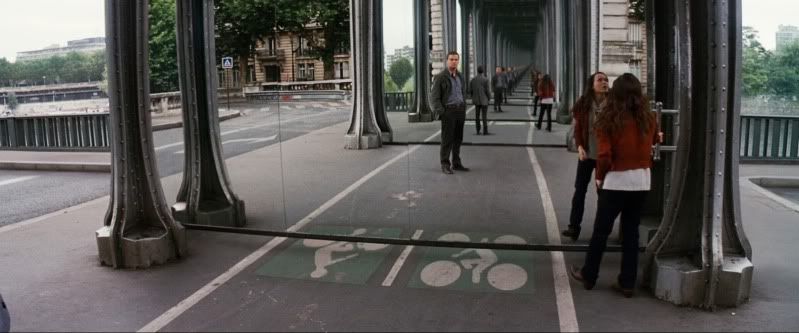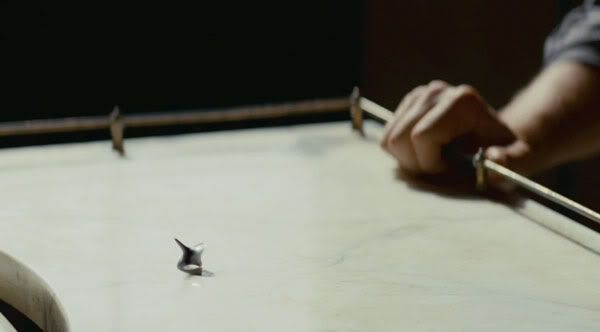 |
| Fig. 1 Inception poster. |

 |
| Fig. 2 Bending reality in a dream. |
The fascinating thing about a dream is it's completely dependant on the dreamer's experiences and emotions towards its content, interpreting the world within it around the dreamer's own beliefs. No matter how unrealistic and twisted it may seem to an outsider it will feel completely real to the dreamer. When speaking about the use of dreams in Inception, Christopher Nolan explained that "You're not just experiencing reality - you're dreaming it for yourself" (Nolan, 2010:19) which is what allows him to portray such interesting ideas and stunning visual interpretations. The dreams that the audience see are filled with real settings, such as shops, cafes, markets, but they can be turned completely upside down by
either being made aware of the fact that they are dreaming and not accepting it or by their 'real world' leaking in. An interesting consideration is a line from a wise old man when the lead character shows disdain to those that spend a long time 'in the dream'. He said that "The dream has become their reality. Who are you to say otherwise?" (Inception, 2010). This is an incredibly postmodern idea, that their reality, whether it is in a dream or in the 'real world', is still their own reality. Everyone has a different take on life, and much like their dreams, it is entirely affected by their experiences and emotional concerns. However, the idea that is really interesting is using someone else, known as the architect, to create their own version of a dream reality that someone else would find believable, should they be placed in there. Using the architect's own interpretation of the real world to craft a dream reality that the 'dreamer' would relate to is quite contrary to postmodern beliefs. As it believes that there would be an interpretation that suits everyone's needs and beliefs about the world around them.
 |
| Fig. 3 Illusion of infinite space. |
Another intriguing aspect of Inception is the use of mirrors and how they relate to postmodernism. Cristopher Nash explains that "postmodern texts repeatedly adopt as a capital object of their attention the mirror itself - the eternal symbol for the reflection of personal truth and self-knowledge and self-regard." (Nash, 2001:15) In one scene (figure 3) the architect, Ariadne, and her mentor, Cobb, are seen peering deep into a mirror. What is wonderful about this is that Ariadne is in fact manipulating Cobb's dream, creating two inward-facing mirrors and by doing so she creates the illusion of depth and the repeated image of herself and Cobb, also known as mise en abyme. Marian Hobson describes mise en abyme as "a series of reflections or internally contained scale-models of the literary work" (Hobson, 1998:75), in this case 'the literary work' would be referring to the image of Cobb and Ariadne. Hobson then goes on to divulge that "such doubles might give consistency and coherence to the literary or pictural work by encapsulating images which reflect the whole, by reinforcing and repeating it." (Hobson, 1998:75); these images could be literally reflecting the whole of the characters in the mirror, but the fact that their image is repeated so much could be interpreted as a portrayal of their traits. Ariadne is close against the mirror, so she isn't as clearly repeated, perhaps because she's so new to invading dreams she hasn't built up too many 'layers' of experience and interpretations. However, Cobb stands alone to the back of the mirror, so his image is clearly repeated all the way into infinity; which indicates how his experiences in dreams has built up so many layers that he has to keep to himself and distance himself from others. When talking about mirrors, Nash revealed that "Never neutral and 'transparent' as it seems...distorting as they reflect, showing never our self but its double in reverse, a negative we can never put right without a further mirror, ever distancing us from ourselves" (Nash, 2001:15) This could see the mirrors used as a metaphor for the levels of dreams that the characters experience. The more levels they delve into, the deeper into the subconscious they get and the further away from returning to 'reality' they are. The mirror in this scene, from figure 3, is a visual representation of the distance Cobb is from his own normality, from his own interpretation of the world.
 |
| Fig. 4 Reality Check. |
The use of differing depths within dreams and the changes in reality that comes with it is another technique of note. As previously mentioned, the dreams all contain usual features that wouldn't seem too out of place, however, the use of repetition within the different levels of dream experience is another postmodern trait. Nash expressed that "in postmodern fiction, houses form within houses, labyrinths within labyrinths, people within persons - the postmodernist's celebrated dicta resonate that no closure is to be found and that there is no outside...beyond the text." (Nash, 2001:16) This quote is key when thinking about Cobb's character. He has formed literal 'houses within houses, labyrinths within labyrinths' in the dream worlds. Every layer he makes is slightly different configurations and at the deepest layer of the subconscious, the layer of 'no return', he builds homes with his wife. The layers of dreaming has challenged his interpretation of reality and, in turn lead to his need to be sure that the reality he is experiencing is the 'real world', he needs the 'closure'. However, as Nash mentioned, there is no closure, there is no outside, and figure 3 is a literal representation of that. There are so many repetitions of himself to indicate how completely unsure he is of his own reality. Another interesting plot device is that at any moment Cobb's projection of his late wife, Mal, might leak into a dream he's in and disrupt everything; his own reality, leaking into, and affecting someone else's.
Throughout Inception, the audience is aware that Cobb's fragile grasp of reality is a constant concern, that the reality the characters are experiencing might in fact be a dream without them realising and that the film's ambiguous final shot could suggest that Cobb is still in a dream and he's created this reality for himself. No matter how it is sliced though, the film is a thoroughly enjoyable and intelligent interpretation of how a person's mind and perception can be manipulated by another without them realising it.
List of Illustrations
Figure 1. Inception (2010) Inception poster. At: http://ubersuper.com/inception-poster-theatrical/ (Accessed on: 03.10.11)
Figure 2. Inception (2010) Bending reality in a dream. At: http://andrewprevett.files.wordpress.com/2011/03/inception-cropped-proto-filmcritic_reviews___entry_default.jpg (Accessed on: 03.10.11)
Figure 3. Inception (2010) Illusion of infinite space. At: https://blogger.googleusercontent.com/img/b/R29vZ2xl/AVvXsEjlac6ukyc58rDh60wD8aFErSXf2d0lYegcUTgjYLGt3X5ku-3iLqq9c7OxCozxuqXorpSmkiFmu2NKNTW1tQRvzQYw5-22tb0NMMw4WpspucUTbRcR8kn-fe9w3K8MSv41cLTyoDlXSL4/s1600/large_inception_blu-ray_4.jpg (Accessed on: 03.10.11)
Figure 4. Inception (2010) Reality Check. At: http://www.doobybrain.com/wp-content/uploads/2010/08/spinning-top-totem-inception.jpg (Accessed on: 03.10.11)
Bibliography
Nash, Cristopher (2001) The unravelling of the postmodern mind. Edinburgh: Edinburgh University Press Ltd.
Nolan, Christopher, Nolan, Jonathan (2010) Inception: The Shooting Script. USA: Insight Editions.
Hobson, Marian (1998) Jacques Derrida: Opening Lines. London: Routledge
Figure 2. Inception (2010) Bending reality in a dream. At: http://andrewprevett.files.wordpress.com/2011/03/inception-cropped-proto-filmcritic_reviews___entry_default.jpg (Accessed on: 03.10.11)
Figure 3. Inception (2010) Illusion of infinite space. At: https://blogger.googleusercontent.com/img/b/R29vZ2xl/AVvXsEjlac6ukyc58rDh60wD8aFErSXf2d0lYegcUTgjYLGt3X5ku-3iLqq9c7OxCozxuqXorpSmkiFmu2NKNTW1tQRvzQYw5-22tb0NMMw4WpspucUTbRcR8kn-fe9w3K8MSv41cLTyoDlXSL4/s1600/large_inception_blu-ray_4.jpg (Accessed on: 03.10.11)
Figure 4. Inception (2010) Reality Check. At: http://www.doobybrain.com/wp-content/uploads/2010/08/spinning-top-totem-inception.jpg (Accessed on: 03.10.11)
Bibliography
Nash, Cristopher (2001) The unravelling of the postmodern mind. Edinburgh: Edinburgh University Press Ltd.
Nolan, Christopher, Nolan, Jonathan (2010) Inception: The Shooting Script. USA: Insight Editions.
Hobson, Marian (1998) Jacques Derrida: Opening Lines. London: Routledge

"in postmodern fiction, houses form within houses, labyrinths within labyrinths, people within persons - the postmodernist's celebrated dicta resonate that no closure is to be found and that there is no outside...beyond the text."
ReplyDeleteMolly! This is the most perfect, delightful quote - absolutely nails Inception, and absolutely underlines the transparency/reflection model for modernity/postmodernity. Well done! :D